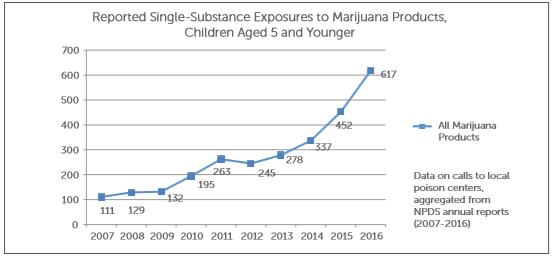When we talk about drug use and education, the conversation often turns towards prevention and treatment for teens and adults.
But the effect of drug use on young children under the age of five can’t be overlooked. In addition to a rising number of children entering foster care each year due to drug-addicted parents, the unintentional exposure to prescription medication led to an increase in poison control center calls in recent years, according to the recently released “Childhood Poisoning: Safeguarding Young Children from Addictive Substances” report by the National Center on Addiction and Substance Abuse.
“The number of opioid exposures in children aged 5 and younger increased by 93.2 percent from 2000 to 2009,” the report said. This is also the time period when the number of opioid prescriptions jumped nationwide.
The good news is that since then the overall numbers have decreased during the past few years (due to better childproof packaging and consumer education).
However, between 2013 and 2015, exposures to fentanyl, oxycodone, and buprenorphine among young children have increased. See their report for more statistics.
“In general, young children are very susceptible to the effects of opioids, which are among the most toxic substances to young children and can be lethal in small doses,” the report says.
Symptoms of opioid exposure include agitation, coma, convulsions, nausea, seizure, slow breathing and more, according to the report.
Marijuana
Unfortunately, accidental exposures to marijuana among young children have increased since 2012 – just as laws around the drug have changed in states across the nation. Marijuana edibles, in states that have legalized the drug for recreational use, are behind many of the incidents. Many edibles look like regular candy and can be enticing for young ones. But they can be more dangerous to children because of their high levels of THC.

(Graph from the “Childhood Poisoning: Safeguarding Young Children from Addictive Substances” report)
Symptoms of marijuana exposure include: abdominal pain, agitation, slow heartbeat, fever, coma, nausea/vomiting, stupor, tremor and more, according to the report.
Protecting Your Kids
You can take steps to protect your young children from unintentionally ingesting your medication. Here are a few tips from the CDC article “Put Keep Your Kids Safe: Put Medicines and Supplements, Including Gummies, Up and Away.”
- Put medication away after use (out of reach and out of sight at all times).
- Make sure the safety cap is secure and locked.
- Talk to your kids about medication safety.
- Make sure any visitors to your home keep their medications away and out of sight as well.
- Be prepared in the event your young child does ingest medicine. You can reach a poison control center at 800.222.1222.
Download the "Childhood Poisoning: Safeguarding Young Children from Addictive Substances" report.
Check out these sites for more information on medication safety:
Up and Away: https://www.upandaway.org/
Safe Kids Worldwide: https://www.safekids.org/tip/medication-safety-tips


